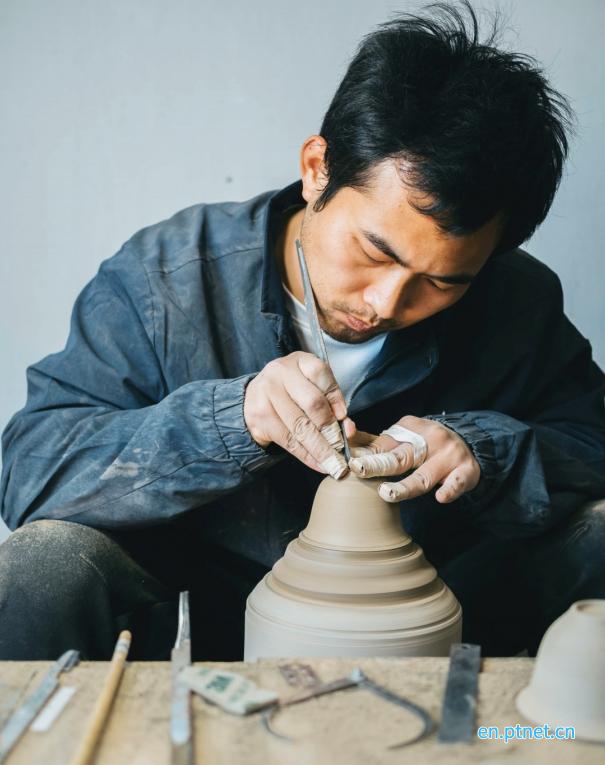Unique sea clay ceramics bring life to Pingtan
en.ptnet.cn | Updated:2024-01-22 | Lin Kongbo, Stephanie
Pottery artisans crafting sea clay
In the picturesque village of Matui on Pingtan Island, the vast expanse of mudflats, shaped by millennia of ocean waves and tides, holds a hidden treasure – sea clay. Thanks to the innovative efforts of the team from Xianghao Technology (Fujian) Co., Ltd., a group of young cultural and tourism enthusiasts, this sea clay is transformed into exquisite sea ceramics, breathing new life into the village and contributing to rural revitalization.

Glazing for the fired sea clay
The intricate process of crafting sea ceramics begins with the collection of unique sea clay from the mudflats of Matui. The clay is then mechanically pressed into circular clay discs and left to dry in the sun for several days, providing the foundation for creating sea ceramics in the workshop.
According to Shi Minghao, the head of the Matui village cultural and tourism development project, sea ceramics are a result of special processing using the distinctive sea clay of Matui. The complex craftsmanship involves multiple stages, including clay extraction, kneading, shaping, drying, applying patterns, initial firing, glazing, kiln loading, and final firing. The entire process, which includes three rounds of firing and meticulous temperature control over two days and nights, gives the sea ceramics their unique qualities.
Inside the workshop, shelves are lined with vessels ready for glazing. Skilled ceramic artisans from Jingdezhen work diligently on the sea clay, imparting their expertise to transform the mudflats' raw material. The sea clay, after initial firing at over 800 degrees Celsius, undergoes glazing and returns to the kiln for final firing, reaching temperatures exceeding 1,200 degrees Celsius. This dual firing process combines the breathability of clay with the density of porcelain, creating the distinctive characteristics of sea ceramics.
Stepping into the exhibition hall feels like entering a small sea ceramic museum. The wooden boat-shaped display table showcases an array of cups – from traditional tea cups to coffee mugs. The diverse forms of these ceramic vessels emanate a rustic charm. Under the spotlight, they transform into a myriad of colors. Astonishingly, these vibrant ceramics are actually from the black sea clay found on the mudflats.

Shi Minghao admiring the sea ceramics
Shi Minghao expresses the team's ambition to expand their product line to include artist series, handmade series, and machine-carved series. They hope to introduce these sea ceramics as distinctive souvenirs during the upcoming tourism season, attracting visitors to Matui village to experience and participate in sea ceramic production.
Matui village, situated by the sea, relies on fishing and aquaculture as its pillar industries. During the fishing season, the sea is a spectacle of fishing boats setting sail with ceramic nets made from sea clay. These nets, used by fishermen to enhance their catch, have become a traditional and practical tool in the local fishing industry.
In the first half of 2020, Matui village's cultural and tourism development project gained momentum. As evening falls, the sunset bathes the expanse of mudflats in red hues, attracting crowds of clam diggers. Among the catch, the team from Xianghao Technology often finds discarded ceramic sinkers on the mudflats. These shapes varied from spherical to tile-like, pique the team's interest.
Upon inquiry with the village elders, the team discovers that these ceramic sinkers were crafted by local fishermen using sea clay for fishing purposes. Inspired by this, the team explored the same clay to create ceramic art. The idea, though ambitious, faced challenges. The team, lacking professional skills and proper kilns, initially experimented with shaping the soft sea clay and microwaving it, resulting in repeated failures due to incorrect proportions and insufficient firing temperatures.
Undeterred, the team embarked on multiple trips to Jingdezhen, the renowned "Porcelain Capital," to learn and improve their craft. After professional assessments confirming that Matui's sea clay contains various minerals and meets safety standards, the team partnered with Jingdezhen Ceramic University. This collaboration led to the development of a new patented formula, and with guidance from domestic ceramic masters, the "Xiangchuan Sea Ceramics" was born.

Sea clay drying in the courtyard
In addition to seeking external expertise, the team plans to introduce more professional equipment and ceramic artisans to expand production. Their goal is to create a team of skilled ceramic makers within Matui village, boosting production and providing a sustainable income source for the villagers. Shi Minghao emphasizes that the promotion of rural revitalization aims to improve the wealth of farmers, aligning with their initial vision when starting the tourism project in Matui village. With confidence, he envisions that "Xiangchuan Sea Ceramics" will soon become a signature cultural and creative product, paving the way for a unique and prosperous future for the village.

 Fujian Public Security Registration Code: 35012802000271
Fujian Public Security Registration Code: 35012802000271